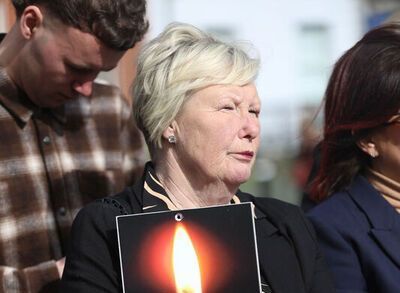Tom Phelan’s critically acclaimed novels include "The Canal Bridge," "Nailer" and most recently “Lies the Mushroom Pickers Told.” Below is the latest extract from his memoir-in-progress about growing up in County Laois in the 1940s and '50s.
By Tom Phelan
Lar Dixon was a lonely, shy and quiet man in his 20s who lived 50 yards beyond our house. Orphaned as a small boy, he spent his early years being handed off to different relatives. His education had been sorely neglected, and reading and writing were beyond him. When he came of age, he took over the small farm his father had bequeathed him.
Lar seldom got up before noon unless his cow bawled to have her painful udder relieved. But it wasn’t the cow’s discomfort that motivated Lar; it was her broadcasting to the neighbors that he was still in bed.
Mam was fond of Lar and had a lot of maternal compassion for him. Whenever it could be done without hurting his pride, she gave him his dinner. She often sent a child out with a plate for him after Dad had gone back to the fields. If Lar had spent a day selling an animal at the Mountmellick fair, Mam saved him bacon, potatoes, and cabbage and kept an eye on the lane to intercept him on his way home.
When Dad hired Lar for a day’s work on our farm, Mam sent one of us children out at half past seven to knock on his bedroom window. She hoped to save a tardy Lar from Dad’s sarcastic tongue.
Once, while helping Dad to reverse a cartful of mangels into the Boiler House, Lar caught his hand between the axle and the wall. Mam took care of the wound. For several weeks, Lar’s hand, along with the bandage, was soaked in warm water, and a new dressing was applied. Every time he left, Mam lamented the thinness of his body and its slowness in repairing itself. In wintertime, his triple-socked feet were always cold even though he stuffed his wellingtons with newspaper he got from Mam.
Lar sometimes worked in our tillage fields or with our horses. Because of this familiarity with the animals, Dad didn’t hesitate to be a good neighbor whenever Lar needed to borrow a horse. He always asked Dad a few days in advance if Lame Mare would be available.
On the morning the horse was needed, Dad went out to the Back of Macks rattling a handful of oats in the bottom of a bucket. Then he tackled Lame Mare and tied her to the hinge of the Boiler House door. But Lar never came for the horse before one o’clock.
Dad complained loudly about Lar’s behavior. ‘That fellow! You’d think he’d be here by now, and he knowing the mare is waiting for him since morning.’
Still, every time Lar asked, Dad got the horse ready first thing, Lar never arrived until afternoon, and Dad groaned.
“The sun’ll be setting soon,” he would say.
Lar would only smile.
When I was about 9, Lar finally saved enough money to buy his own horse. One day he turned him loose to graze in his Tocker field where a plough had been carelessly left. That night, perhaps frightened by something in its own imagination, the horse galloped straight into one of the plough’s wooden handles. It sank deep into the right side of its chest. When Lar heard the wounded animal’s screams, he managed to walk him home, where it died in his tiny stable, originally built for a donkey.
When my brother Eddie and I went to see the dead animal, it had half collapsed against two corner walls, its terrified eyes wide open, its long yellow teeth bared in raging pain. We watched as Dad used chains and Lame Mare to drag the corpse out to the nearest field for burial.
It took a long time for the child I was then to bury the frightening image of the horse’s face, and even today certain wafting odors can drag it to the surface.
“Poor old Lar,” Mam often said. “He’s not had one good day in his life.”
Lar died in his 40s. Whenever I’m in Ireland, I stand by his grave, remembering the time he had a swollen jaw from a bad tooth as well as a pronounced limp from broken toes. I was a young teenager then. For a laugh at his expense, I quipped that Lar had hoof-and-mouth disease.
The things we regret.
For more information about Tom, see www.tomphelan.net.










